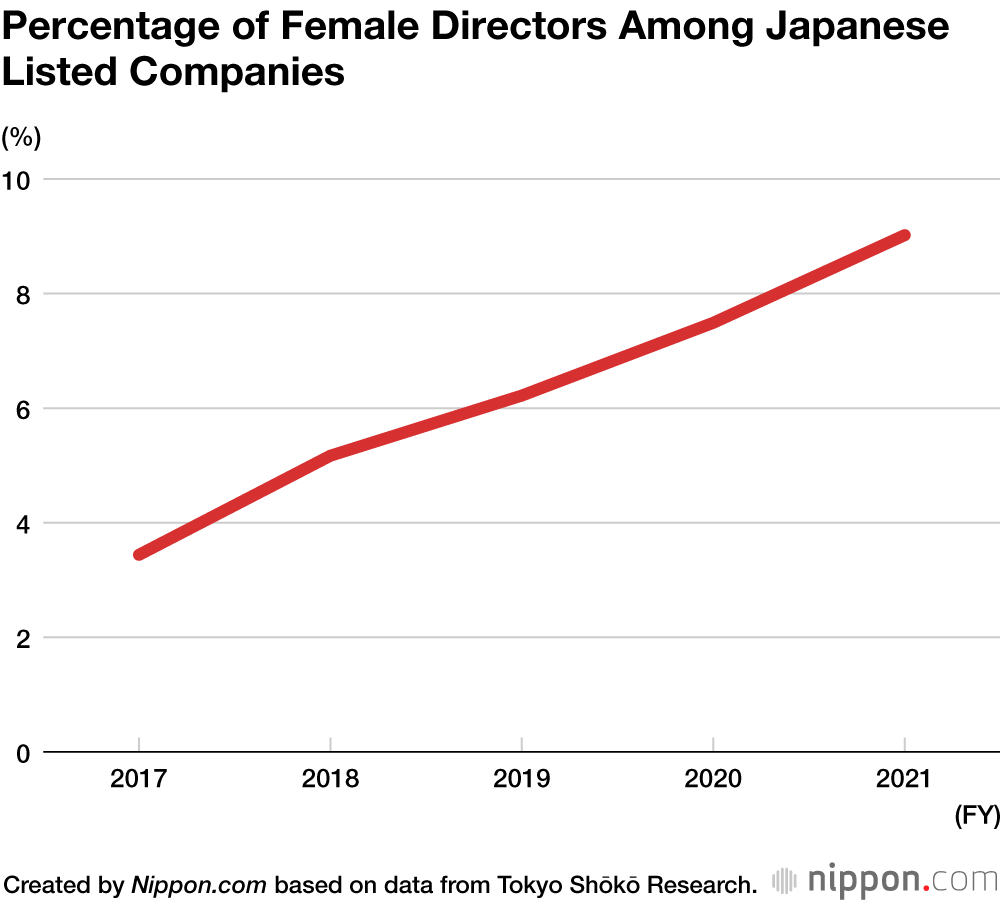
Number of Female Directors at Japan’s Listed Companies Reaches 3,000 for the First Time
Gender and Sex Economy Society Work- English
- 日本語
- 简体字
- 繁體字
- Français
- Español
- العربية
- Русский
A survey conducted by the private research firm Tokyo Shōkō Research found that the number of female directors among 3,795 listed companies in Japan reached 3,575 in fiscal 2021, a 21.8% increase over the previous year. This marked the first time for the number to surpass 3,000. The overall proportion of female directors was 9%, a slight increase over the 7.4% in the previous year. The company with the highest percentage of female directors was the wireless communications manufacturer Uniden Holdings, at 60%. A total of seven companies had 50% or more female directors.
Companies with the Highest Percentage of Female Directors in Fiscal 2021
| Company name | Industry type | (FY2020) |
|---|---|---|
| Uniden Holdings Corp. | Electric appliances | 60% (10%) |
| Hikari Heights Varus | Services | 50% (57.1%) |
| Lawson | Retail | 50% (50%) |
| San’yōdō Holdings | Retail | 50% (40%) |
| AI CROSS | Information and communications | 50% (50%) |
| Newtech | Electric appliances | 50% (25%) |
| CellSeed | Precision instruments | 50% (50%) |
| Shiseidō | Chemicals (Cosmetics) | 46.2% (46.2%) |
| M3 | Services | 44.4% (33.3%) |
| C’Bon Cosmetics | Chemicals (Cosmetics) | 44.4% (55.6%) |
Created by Nippon.com based on data from Tokyo Shōkō Research.
Meanwhile, nearly 40% of the listed companies had no female directors. These companies were found in the real-estate sector, the wholesale industry, and the transportation and ICT sectors.
Market pressure is one factor behind the increase in the number of female directors. The Tokyo Stock Exchange’s Corporate Governance Code requires companies to “secure diverse human resources,” and institutional investors also view the presence or absence of female executives as a criterion for investment decisions. There is a growing movement among domestic and foreign institutional investors to consider voting against proposed boards of directors if they include no women.
Among listed companies, those on the TSE Prime Market have the highest percentage of female directors, at 11.4%, reflecting the tendency for there to be more female leaders in those markets where investors are more demanding.
However, the majority of female directors are outside directors appointed from the ranks of lawyers, accountants, and university professors, rather than directors appointed internally. For example, at the 311 companies that appointed a female director for the first time in fiscal 2021, 91.9% of female directors were outside directors.
An official from Tokyo Shōkō Research indicated that “it would be preferable to have female employees promoted internally as directors, rather than the numbers being padded through external appointments” and pointed to the need to “pay attention to the true state of affairs.”
(Translated from Japanese. Banner photo © Pixta.)
